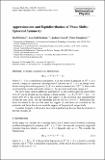Approximation and Equidistribution of Phase Shifts: Spherical Symmetry
Author(s)
Datchev, Kiril; Gell-Redman, Jesse; Hassell, Andrew; Humphries, Peter
Download220_2013_Article_1841.pdf (398.0Kb)
PUBLISHER_POLICY
Publisher Policy
Article is made available in accordance with the publisher's policy and may be subject to US copyright law. Please refer to the publisher's site for terms of use.
Terms of use
Metadata
Show full item recordAbstract
Consider a semiclassical Hamiltonian H[subscript V,h]:=h[superscript 2] Δ + V − E, where h > 0 is a semiclassical parameter, Δ is the positive Laplacian on R[superscript d],V is a smooth, compactly supported central potential function and E > 0 is an energy level. In this setting the scattering matrix S[subscript h](E) is a unitary operator on L[superscript 2](S[superscript d−1]), hence with spectrum lying on the unit circle; moreover, the spectrum is discrete except at 1. We show under certain additional assumptions on the potential that the eigenvalues of S[subscript h](E) can be divided into two classes: a finite number ∼c[subscript d](R√E/h)[superscript d−1], as h→0, where B(0, R) is the convex hull of the support of the potential, that equidistribute around the unit circle, and the remainder that are all very close to 1. Semiclassically, these are related to the rays that meet the support of, and hence are scattered by, the potential, and those that do not meet the support of the potential, respectively. A similar property is shown for the obstacle problem in the case that the obstacle is the ball of radius R.
Date issued
2013-11Department
Massachusetts Institute of Technology. Department of MathematicsJournal
Communications in Mathematical Physics
Publisher
Springer Berlin Heidelberg
Citation
Datchev, Kiril et al. “Approximation and Equidistribution of Phase Shifts: Spherical Symmetry.” Communications in Mathematical Physics 326.1 (2014): 209–236.
Version: Author's final manuscript
ISSN
0010-3616
1432-0916